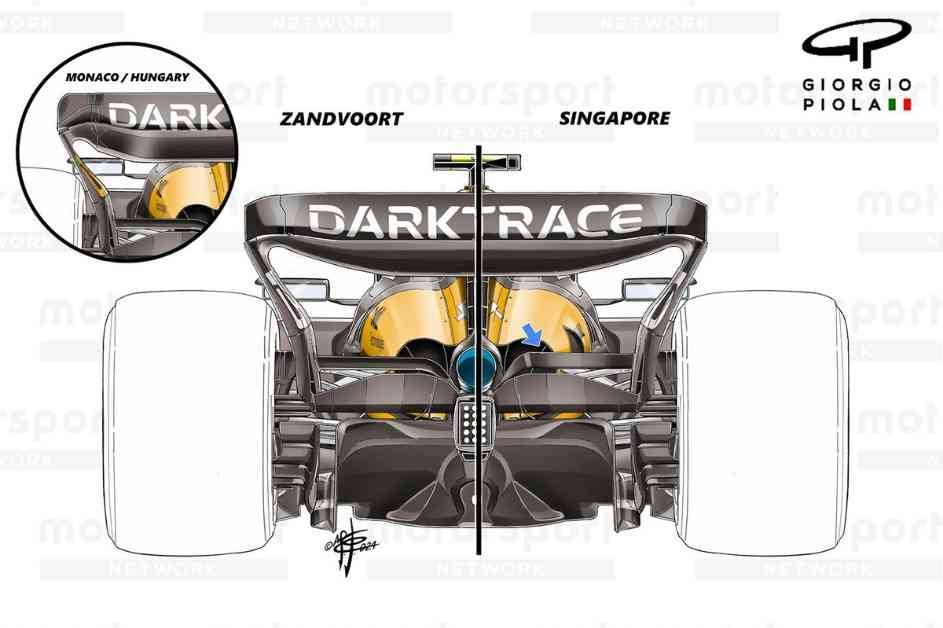McLaren’s Unique Rear Wing Design
During the Singapore Grand Prix, McLaren’s rear wing design stood out as a unique and innovative choice in the world of Formula 1. While most teams opted for maximum downforce levels to navigate the challenging street circuit, McLaren went against the grain by selecting a lower downforce setting.
This decision was not taken lightly, as the team experimented with different configurations throughout the weekend. Oscar Piastri initially tested the max downforce arrangement in FP1 before switching to the lower downforce level that Lando Norris had been running from the start. This strategic move set McLaren apart from its competitors and showcased the team’s willingness to think outside the box when it came to aerodynamic setups.
One of the key elements of McLaren’s rear wing design was the updated beam wing arrangement. While still maintaining a bi-plane layout, the team made adjustments to improve the relationship between the two elements and enhance the connection with the diffuser and rear wing. This innovative approach helped McLaren bridge the gap between downforce levels and optimize performance on the demanding Singapore street track.
McLaren’s ‘Mini-DRS’ Controversy
McLaren’s rear wing design also sparked controversy during the Singapore Grand Prix, particularly with the introduction of the ‘mini-DRS’. This unique feature, which was first noticed in Baku, allowed for flexibility in the rear wing to reduce drag and increase straight-line speed.
Unlike traditional methods of reducing drag, McLaren’s ‘mini-DRS’ utilized a new approach that involved the leading edge of the upper flap flexing upwards. This innovative design was expected to provide a top speed boost compared to other teams, although the exact performance gains were not immediately clear.
While the wing passed the FIA regulations in static load tests, pressure from rivals prompted McLaren to make modifications to the low-downforce specification for future races. Despite the controversy surrounding the ‘mini-DRS’, McLaren’s willingness to push the boundaries of aerodynamic design showcased the team’s commitment to finding competitive advantages on the track.
Red Bull’s Technical Tweaks
In contrast to McLaren’s bold aerodynamic choices, Red Bull Racing focused on technical tweaks to improve performance during the Singapore Grand Prix. The team, which had been struggling with the performance of the RB20 throughout the season, made adjustments to the front brake assembly in an effort to enhance brake cooling and heat transfer to the tires.
By modifying the front brake assembly, Red Bull aimed to optimize the transmission of heat between the brakes and tires via the wheel rim. This small detail change, while less obvious with the current generation of cars, highlighted Red Bull’s attention to detail and commitment to maximizing performance on a race-by-race basis.
The design of the inner basket was altered to include a trench-like cutout with a window around a portion of the brake disc, which also acted as a heatsink. This new arrangement rerouted heat generated by the brakes around the assembly and out the rear-facing duct mounted on the inboard face of the brake duct fence. These technical tweaks represented Red Bull’s ongoing efforts to address performance issues and stay competitive in the highly competitive world of Formula 1.
Ferrari’s Front Wing Innovation
Meanwhile, Ferrari introduced a new front wing design at the Singapore Grand Prix to capitalize on the performance gains from recent floor updates. Originally scheduled for the United States Grand Prix, the new front wing was fast-tracked to Singapore to enhance the car’s aerodynamic performance on the challenging street circuit.
The focus of Ferrari’s front wing design was on flexibility under load, with an emphasis on tuning the vortex split in the outer corner to improve aerodynamic efficiency. The team took a similar approach to McLaren by incorporating a more aggressively dog-eared semi-detached flap design to optimize the airflow around the front end of the car.
Adjustments were made to the shape and distribution of the flaps to better suit the shift in outboard characteristics and enhance overall performance in terms of downforce and drag. Additionally, changes to the central section of the mainplane, including the depth and transitional shape of the drooped section, further improved the aerodynamic efficiency of the front wing.
Overall, Ferrari’s front wing innovation exemplified the team’s commitment to pushing the boundaries of aerodynamic design and staying competitive in the ever-evolving world of Formula 1.












